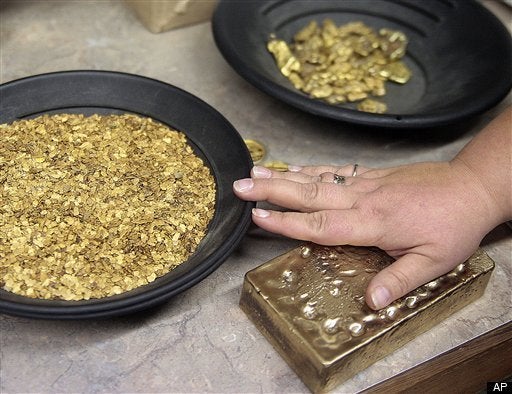
All that glitters seems to be gold. With the metal at $1,371 per ounce, up from $800, the two-year return on bullion is approximately 70%. In 2008, comparatively late to the long-running gold party, we purchased the GDX (gold mining stocks exchange traded fund) across client accounts in cautiously small weightings. Obviously, we should have bought more.
Returns that approach 100% in short periods of time are unsustainable. Gold may climb for awhile, but at some point it will fall -- with all the force of gravity a heavy metal can provide.
Consider that gold has been a terrible long-term investment over the past century. By way of illustration: in 1910, one ounce of gold bought a decent men's suit -- and it still does today. In other words, over that time gold has provided zero real return (above and beyond the inflation rate). Contrast this with stocks which have provided a 7% real return, and you begin to appreciate the difference. One that thing that worries me is that, at $1,346, an ounce of gold nearly fetches a really nice men's suit: think Armani, not a knockoff. And that's the trouble. When gold starts providing some sort of real return above and beyond inflation, you have to worry, because it normally doesn't.
Gold is a story of tremendous spikes -- when people panic about inflation or currency debasement -- and harrowing collapses, once sound currency returns. From 1971-1981, as inflation vexed the American economy, gold returned 28% a year, but then lost money over the next two decades. As Volcker restored a stable price level via high interest rates, gold lost its luster.
History will rhyme, if not repeat. Gold is ultimately a commodity, with few uses beyond jewelry and hoarding. It costs quite a bit to unearth and offers little in return. Expensive to store and secure, it also pays no interest. In short, it's only value lies in its rarity -- and such rarity is only attractive at times when dollars are anything but. An ounce of gold cannot create wealth like a company, can't enjoy economies of scale and doesn't pay a dividend. Gold mining stocks do these things, however, and are thus more attractive than bullion. But gold mining stocks are now fully valued, or even overvalued. At free cash flow yields below 3%, gold mining stocks need metal prices to stay in the stratosphere to maintain their own price levels.
Gold itself cannot be accurately valued, given that it provides no yield. Valuing gold is no different than valuing a currency: impossible yet commonly attempted. But when an investment throws off no cash, there's no way of discounting its present value -- or of comparing it to other opportunities.
As you know, we don't believe anyone can predict the short-term direction of prices in anything: stocks, bonds, livestock, or certainly gold. Since we can't value gold accurately either, the asset is more dangerous than most.
Gold is clearly in a "bubble," but bubbles can expand for very long periods of time before they pop -- usually longer than the most lengthy of predictions. Despite more and more cocktail chatter about gold, the aura surrounding the metal still doesn't approach the internet frenzy, or the real estate mania, or even the euphoria of gold bulls in the 70's. Until it does, gold will not collapse. A bubble only bursts once the last doubter climbs aboard. There are still too many naysayers loudly condemning gold. When the ultimate erstwhile cynic capitulates and cries "Buy gold!" that will mark the top. I don't believe that time has yet arrived.
On the other hand, we believe in selling assets that are overvalued. When dealing with a likely overpriced asset that can't even be properly valued, it's better to be too early than too late. Waiting until inflation and interest rates rise is probably a losing strategy; by then, gold will have already long priced in that reality. Our contrarian philosophy dictates selling an asset class when people are optimistic about its prospects, and that seems to be the current mood surrounding gold. So we've sold our holdings of the GDX. Gold looks a little gaudy in this light.
